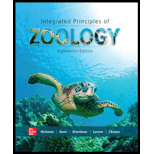
Concept explainers
Describe the evolution of mammals, tracing their synapsid lineage from early amniote ancestors to true mammals. How would you distinguish pelycosaurs, early therapsids, cynodonts, and mammals?
To describe: Mammals’ evolution by outlining synapsid lineage starting from early amniote ancestors to that of true mammals.
Introduction: The living amniotes are classified under two clades, namely, Mammalia, and Reptilia (which include birds, crocodilians, lepidosaurs, and turtles). The mammals, as well as the extinct closest relatives of mammals, contain a single pair of openings in the skull’s temporal region; therefore, they are called synapsids.
Explanation of Solution
The first group of amniotes that diversified extensively into terrestrial habitats is the synapsids. Pelycosaurs were the earliest synapsids found in the early Permian period, and they resembled lizards, but they do not share the features of lizards. From one of the groups of pelycosaurs, therapsids have emerged and are the only group of synapsids that entered the Mesozoic era. Therapsids evolved and diversified into many carnivorous and herbivorous forms. They became extinct at the end of the Permian period. However, one group of therapsids survived and entered into the Mesozoic era, and this group was termed as cynodonts. They diversified and gave rise to mammals during the Triassic period. The evolution of mammals was accompanied by the derivation of many important features. The diversification of mammals started in the Cretaceous period. The modern orders emerged in the Cenozoic era. Large-bodied mammals were greatly diversified during the ice ages of Pleistocene. At the Pleistocene epoch’s end, most of the diversified mammals became extinct due to habitat changes and hunting by modern humans.
To describe: The way in which mammals, cynodonts, early therapsids, and pelycosaurs are distinguished.
Explanation of Solution
Pelycosaurs: They are characterized based on their resemblance to lizards.
Early therapsids: They had an erect gait having upright limbs that is positioned beneath their body. The cerebellum, which is the brain’s muscular coordination center, assumed an extended role.
Cynodonts: They evolved certain characteristics such as powerful jaw musculature, nasal cavity’s turbinate bones, heterodont teeth, and secondary palate.
Mammals: Mammals are differentiated by their mammary glands, hair, ear ossicles, and diphyodont teeth.
Want to see more full solutions like this?
Chapter 28 Solutions
Loose Leaf For Integrated Principles Of Zoology
Additional Science Textbook Solutions
Human Physiology: An Integrated Approach (8th Edition)
Genetic Analysis: An Integrated Approach (2nd Edition)
Essentials of Human Anatomy & Physiology (11th Edition)
Fundamentals of Anatomy & Physiology (11th Edition)
Campbell Biology in Focus (2nd Edition)
- What is present on the feet of birds which provides more evidence for their evolution from reptiles and dinosaurs?arrow_forwardDescribe the evolution of mammals, tracing their synapsid ancestry from early amniote ancestors to true mammals.arrow_forwardIn your own words: In which ways does the limb orientation of "advanced" tetrapods differ from that of "primitive" tetrapods? What variations have the manus undergone in the evolution of flight (birds, bats, & pterosaurs), swimming, running, & grasping?arrow_forward
- How would you distinguish pelycosaurs, early therapsids, cynodonts and mammals?arrow_forwardHow does the limb orientation of "advanced" tetrapods differ from that of "primitive" tetrapods? How much variation is there in the humeri, radii, and ulnas of tetrapods? What modifications has the manus undergone in the evolution of flight (birds, bats, & pterosaurs), swimming, running, & grasping?arrow_forwardIn what ways is the dogfish skeleton not a good example of the primitive vertebrate condition?arrow_forward
- Can fossils bridge the evolutionary gap between fish and tetrapod vertebrates?arrow_forwardThe evolution of which of the following features of mammals is hardest to trace through the fossil record? a. Jaw structure b. Mammary glands c. Middle ear structure d. Development of hairarrow_forwardAre there any major differences between extant apes skulls and old world monkey skulls? Take into account their anatomy, structure, and dentition.arrow_forward
- How does the alligator snout become elongated relative to the salamander’s? Does it add new bones, or change the shape of pre-existing (in amphibian ancestors) bones?arrow_forwardDescribe structural and functional adaptations that appeared in early amniotes that foreshadowed the mammalian body plan. Which mammalian attributes do you think were especially important to successful diversification of mammals?arrow_forwardMammals belong to a group of amniotes known as synapsids. Three major lineages of mammals had emerged by the early Cretaceous period. In a tabulated form, compare these three lineages to illustrate their diversity in terms of: a. Embryonic developmen, b. How the young are fed and c. Period of gestationarrow_forward
 Biology: The Dynamic Science (MindTap Course List)BiologyISBN:9781305389892Author:Peter J. Russell, Paul E. Hertz, Beverly McMillanPublisher:Cengage Learning
Biology: The Dynamic Science (MindTap Course List)BiologyISBN:9781305389892Author:Peter J. Russell, Paul E. Hertz, Beverly McMillanPublisher:Cengage Learning Biology (MindTap Course List)BiologyISBN:9781337392938Author:Eldra Solomon, Charles Martin, Diana W. Martin, Linda R. BergPublisher:Cengage Learning
Biology (MindTap Course List)BiologyISBN:9781337392938Author:Eldra Solomon, Charles Martin, Diana W. Martin, Linda R. BergPublisher:Cengage Learning

